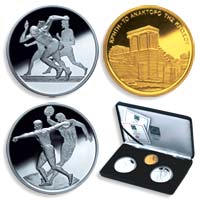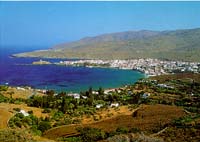|
Greeks love garlic - in
sauces, dips, stews, roast lamb, and even in their pockets!. A
popular superstition says that garlic protects against the evil eye.
If a child looks attractive, inviting the envy of others, the mother
may take a little precaution by tucking a clove of garlic in the
child's pocket.
Such folk superstitions are common
among Greeks and many other nationalities. The superstitions below
probably span thousands of years and thousands of miles. Most Greek
Americans view them as fun and colorful - a form of amusement - yet
many give lip service to at least a few!
Preventing Misfortune
Jinxing
Do not spoil a good thing by bragging
or predicting success. Overconfidence can bring failure. For
example, never brag that you will get an "A" on a test before it is
returned or make a million when the deal is closed. If you boast
ahead of time, you may fail. Even in ancient times, myth had it that
the gods chastised those who became too over confidant. When the
triumphant Agamemnon returned home as a conquering hero from the
Trojan War, he walked on a purple carpet reserved only for the gods.
His arrogance offended them, leading to his downfall.
Knock on wood (Ktίpa Ksίlo)
Knock on wood to keep a good thing from going wrong. This is a
cousin to the idea of jinxing. If you must predict that something
will go well, for example, "It looks like the sun will shine for the
wedding," knock on wood several times to keep away the rain. This
custom may have religious origins, May early Christians carried
pieces of wood believed to be part of the original cross. When in
danger, they touched the wood, receiving God's protective power.
Prevent third misfortune
Some believe bad things happen in three's. After two bad things have
occurred (such as two funerals) say, "Na min tritósi" (May it
not triple") to prevent a third unfortunate event.
Evil Eye: Identification and folk remedies
Contrary to popular opinion, the evil eye (vaskanίa) is recognized by the church as a legitimate religious
phenomenon. It is part of a larger picture of evil generated by the
devil. The church helps its parishioners exorcise the evil eye with
a prayer offered by the priest. Some people practice the following
folk remedies, even though the church discourages their use.
Identification
A popular folk method to determine if someone has the evil eye is to
put three drops of oil in a glass of water. If the oil stays
separate from the water, you do not have it. If the oil blends with
the water, you do.
Preventing the evil eye
"Ptoú, ptoú,"
The most common protection against the evil eye is the simple
phrase, "Ptoú, ptoú," said immediately after receiving a
complement. A cautious Greek parent upon hearing, "Your daughter is
so smart," would encounter with "Ptoú, ptoú," to keep the
evil eye from harming her. Or it might be said by the person who
gives the compliment. The phrase is a verbalizing of spitting to
scare away evil spirits. In the Orthodox baptismal service, the
godparent spits three times and denounces Satan.
Na mi se matiáso (Not to eye you)
One way of giving a compliment without bringing on the evil eye is
to end the remark with, "Na mi se matiáso" or "Ptoú, ptoú,
na mise matiáso." This lets the person know that you are not
putting on the evil eye.
Eye over the door
Some homes keep a picture of an eye over the main entryway to dispel
envy brought in from the outside.
Matί The
matί ("eye") is a folk talisman made of blue stone, glass, or
plastic with a black eye in the center. It is commonly given
to newborn babies and pinned to clothing at the upper back. Adults
also wear it as a pin, a necklace, on a charm bracelet, and even on
the same chain as their cross. Although frequently viewed with
amusement, the matί evokes a skeptical respect from even the
most sophisticated!
Layman's Prayer (Ksemátiasma)
Another folk remedy employed by the Greeks to dispel the evil eye is
a ritual prayer (ksemátiasma) that is passed on orally. The
prayer cannot be written, or, legend says, it will lose its power.
If you are a woman, you must learn it from a man; if you are a man,
from a woman. It is passed on when the bearer is old as the bearer's
power is lost once the prayer is revealed.
Miscellaneous
Use the same door
Use the same door when entering and leaving someone else's
house. To not do so, invites bad luck on an impending matter, such
as marriage proposal or a business deal.
Reading coffee cups
After finishing a cup of Greek coffee, swirl the dregs, turn the
cup over into a saucer and cool. The grounds from unique patterns
inside the cup that are then read by a fortune teller (kafetzoú).
This is a common form of entertainment.
Beware of knives
Do not hand a knife directly to someone, or you will have
an argument. Lay it down, and have the person pick it up. If you
hand a knife, say "Ptoú, ptoú."
Ringing Ears
You will hear some news
Sneeze
If you sneeze, you are telling the truth, or someone is talking
about you.
Rece0iving soap, knife, cologne, and handkerchiefs
If you are given a handkerchief, cologne, or a knife, hand the
person a penny to avoid an argument and loss of friendship. Never
give a friend soap as a gift or hand it to them. It washes away the
friendship.
Fold in bedspread
Fold up the corner of the bedspread before going on a trip, so
that you will return safely.
Excerpt from the book Greek Traditions and Customs
|

 May
Recipe:
May
Recipe:























 (Area
13 4 sq. km. Distance from Piraeus 138 nautical miles).
(Area
13 4 sq. km. Distance from Piraeus 138 nautical miles).


